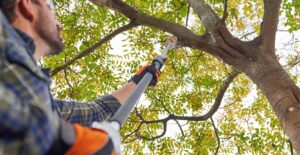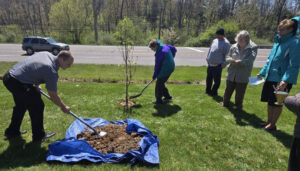Removing a tree yourself can be a cost-effective way to manage your landscape, but it comes with significant risks. Proper planning, safety precautions, and the right equipment are crucial to completing the job safely and efficiently. This guide will walk you through essential tips and techniques for DIY tree removal, covering everything from safety measures to stump removal. Whether you’re dealing with a small sapling or a larger, diseased tree, these steps will help you navigate the process with confidence.
1. Safety Precautions for DIY Tree Removal
Safety should be your top priority when undertaking tree removal. This task involves the use of heavy tools, falling wood, and potentially dangerous conditions. Here’s how to protect yourself:
Protective Gear:
Always wear the appropriate protective gear:
- Chaps: Protects your legs from chainsaw accidents.
- Safety Glasses: Shields your eyes from flying debris.
- Earplugs: Protects your ears from loud equipment noise.
- Leather Boots: Provides foot protection and stability.
- Long Pants and Long-Sleeved Shirt: Guards against cuts, scrapes, and sun exposure.
Teamwork:
Never attempt tree removal alone. Having a partner on hand can help manage tools, guide the tree’s fall, and assist in emergencies.
Emergency Plan:
Know the location of the nearest hospital or have emergency services contact information readily available. Always keep a first aid kit close by.
Power Tool Safety:
Ensure your chainsaw is in good working condition, and you are familiar with its operation. Sharpen the chain, check the fuel levels, and test the brakes.
2. Planning Escape Routes
Having an escape plan is crucial when cutting down a tree. A falling tree can be unpredictable, so planning two clear escape routes can protect you if the tree doesn’t fall as expected.
Steps to Plan Your Escape:
- Determine Fall Direction: Before cutting, assess the tree’s lean and weight distribution to predict its fall.
- Clear Escape Paths: Make sure your escape routes are free of debris, branches, or any tripping hazards.
- Positioning: Stand at a 45-degree angle from the fall line of the tree during the cutting process.
Practice Runs:
Walk through your escape routes before making any cuts to ensure familiarity and confidence in your movements.
3. Checking for Utilities
One of the most critical steps in DIY tree removal is ensuring that your tree removal efforts don’t interfere with utility lines. Overhead power lines and underground utilities can pose significant hazards.
Overhead Utilities:
- Power Lines: If your tree is near power lines, it’s best to hire a professional. The risk of electrocution is high.
- Cable and Telephone Lines: These lines can also be dangerous and should be carefully considered.
Underground Utilities:
- Call Before You Dig: Dial 811 in the U.S. before starting any digging work to locate underground utilities such as gas, water, or sewer lines.
- Survey the Area: Mark all identified utilities clearly to avoid accidental damage.
Table: Common Utilities and Risks
| Utility Type | Risk | Safety Measure |
|---|---|---|
| Power Lines | Electrocution | Hire a professional for nearby trees. |
| Telephone/Cable Lines | Service disruption, minor shock risk | Avoid and work with caution. |
| Underground Gas Lines | Explosion, severe injury | Call 811 to locate and avoid. |
| Water Lines | Flooding, property damage | Call 811 to locate and avoid. |
| Sewer Lines | Sewage backup, environmental damage | Call 811 to locate and avoid. |
4. Clearing the Area Around the Tree
Creating a safe work zone is essential for controlling the tree’s fall and minimizing damage. This involves removing obstacles and securing the area where branches may fall.
Steps to Clear the Area:
- Remove Valuables: Move vehicles, garden furniture, and any valuable objects.
- Prune Lower Branches: Cut off lower branches to create a clear path for the tree’s fall.
- Clear Debris: Rake away leaves, sticks, and any other debris to ensure you have a stable surface to work on.
Safety Tip:
Notify neighbors and keep pets and children away from the area to avoid accidental injuries.
5. Cutting a Notch in the Tree
Cutting a notch in the tree is a critical step that determines the direction in which the tree will fall. The notch guides the tree’s descent and gives you control over the process.
Steps to Cut a Notch:
- Horizontal Cut: Start with a horizontal cut about 1/5 to 1/3 of the tree’s diameter at chest height. This will be the base of your notch.
- Angled Cut: Make a second cut at a 45-degree angle, meeting the first cut to remove a wedge-shaped piece of wood.
- Direction Control: The notch should be aimed in the direction you want the tree to fall.
Bullet Points for a Perfect Notch:
- Keep the cuts as even and smooth as possible.
- Ensure the depth of the notch is correct to prevent the tree from snapping unpredictably.
- Aim for a 70-degree opening between the cuts for optimal control.
6. Using Wedges for Larger Trees
For trees with a diameter larger than 18 inches, wedges become essential. They prevent your chainsaw from getting pinched and help guide the tree’s fall.
Using Wedges:
- Insert Wedges: Once you have made your notch, start the back cut slightly above the notch cut and insert wedges to keep the cut open.
- Drive Wedges: Tap the wedges in gently but firmly with a sledgehammer to support the tree’s weight.
- Continue Cutting: As you continue to cut, keep an eye on the tree’s movement and adjust the wedges as needed to ensure a controlled fall.
Types of Wedges:
- Plastic Wedges: Used to prevent saw damage and offer lightweight handling.
- Metal Wedges: Heavier and more durable, ideal for larger trees or tougher jobs.
7. Estimating the Tree’s Fall
Estimating how a tree will fall requires a careful assessment of its condition, weight distribution, and surrounding environment. Uneven growth, disease, or structural damage can alter the fall trajectory.
Steps to Estimate Tree Fall:
- Assess Lean and Weight: Identify which side the tree naturally leans towards and if one side has more branches or foliage.
- Check for Rot or Disease: Look for any signs of decay, which can weaken the structure and alter the fall.
- Plan for the Unexpected: Consider wind direction and strength, which can affect the tree’s fall path.
Visual Estimation Tips:
- Use a plumb line to check the verticality of the tree.
- Mark the expected fall zone with ropes or flags to visually gauge and plan your cut.
8. Stump Removal: Cover and Deprive of Light
After the tree has been successfully removed, dealing with the stump is the final step. A lingering stump can be an eyesore and a tripping hazard.
Steps for Stump Removal:
- Cover the Stump: Use a tarp or plastic cover to deprive the stump of sunlight, which inhibits growth.
- Wait Period: Leave the stump covered for several months, periodically checking for signs of decay.
- Dig Out: Once the stump is weakened, use a shovel or pickaxe to remove it from the ground.
Additional Tips:
- Chemical Stump Removal: Use stump removal chemicals to speed up the decay process.
- Natural Methods: Pour hot water or apply Epsom salt to accelerate decomposition.
Table: Stump Removal Methods
| Method | Time Required | Pros | Cons |
|---|---|---|---|
| Cover and Deprive of Light | 6-12 months | Low cost, natural method | Long time frame |
| Chemical Removal | 4-6 weeks | Faster results | Requires chemicals |
| Manual Digging | 1-2 days | Immediate removal | Labor-intensive |
Notes:
DIY tree removal can be a manageable task with the right preparation, tools, and safety measures. By following the outlined steps—from assessing the tree and its surroundings to ensuring your own safety with proper gear and escape routes—you can successfully remove a tree without the need for professional services. Remember, safety is paramount; never take shortcuts or attempt to remove a tree without a clear understanding of the process and potential hazards involved. For particularly large or hazardous trees, it’s always wise to consult or hire a professional to mitigate risks.




